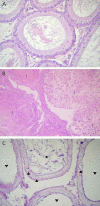Spermatotoxic effects of α-chlorohydrin in rats
- PMID: 22474469
- PMCID: PMC3315198
- DOI: 10.5625/lar.2012.28.1.11
Spermatotoxic effects of α-chlorohydrin in rats
Abstract
This study was conducted to investigate the potential effects of α-chlorohydrin (ACH) on epididymal function and antioxidant system in male rats. The test chemical was administered to male rats by gavage at doses of 0, 3, 10, and 30 mg/kg/day for 7 days. Twenty-four male rats were randomly assigned to four experimental groups, with six rats in each group. Spermatotoxicity was assessed by measurement of reproductive organ weight, testicular sperm head count, epididymal sperm motility and morphology, histopathologic examination, and oxidative damage analysis in rats. At 30 mg/kg/day, an increase in the incidence of clinical signs, epididymis weight, and gross necropsy findings of the epididymis, a decrease in the sperm motility, and an increased incidence of histopathological changes of the epididymis were observed in a dose-dependent manner. At 10 mg/kg/day, an increased incidence of clinical signs and histopathological changes and decreased sperm motility were observed. In the oxidative damage analysis, an increase in the malondialdehyde concentration and a decrease in the glutathione content and glutathione peroxidase and catalase activities in the epididymal tissue were detected at ≥3 mg/kg/day. The results show that graded doses of ACH elicit depletion of the antioxidant defense system and that the spermatotoxicity of ACH may be due to the induction of oxidative stress.
Keywords: oxidative stress; reproductive dysfunction; sperm; α-Chlorohydrin.
Figures

Similar articles
-
Ameliorative effects of pine bark extract on spermatotoxicity by α-chlorohydrin in rats.Phytother Res. 2014 Mar;28(3):451-7. doi: 10.1002/ptr.5016. Epub 2013 Jun 21. Phytother Res. 2014. PMID: 23788506
-
Utilization of a short-term male reproductive toxicity study design to examine effects of alpha-chlorohydrin (3-chloro-1,2-propanediol).Reprod Toxicol. 1994 May-Jun;8(3):237-50. doi: 10.1016/0890-6238(94)90008-6. Reprod Toxicol. 1994. PMID: 8075513
-
The effect of methoxychlor on the epididymal antioxidant system of adult rats.Reprod Toxicol. 2002 Mar-Apr;16(2):161-72. doi: 10.1016/s0890-6238(02)00002-3. Reprod Toxicol. 2002. PMID: 11955947
-
Induction of oxidative stress by bisphenol A in the epididymal sperm of rats.Toxicology. 2003 Mar 14;185(1-2):119-27. doi: 10.1016/s0300-483x(02)00597-8. Toxicology. 2003. PMID: 12505450
-
Toxicology and carcinogenesis studies of androstenedione (CAS No. 63-05-8) in F344/N rats and B6C3F1 mice (gavage studies).Natl Toxicol Program Tech Rep Ser. 2010 Sep;(560):1, 7-31,33-171 passim. Natl Toxicol Program Tech Rep Ser. 2010. PMID: 21037592 Review.
Cited by
-
Update of the risk assessment on 3-monochloropropane diol and its fatty acid esters.EFSA J. 2018 Jan 10;16(1):e05083. doi: 10.2903/j.efsa.2018.5083. eCollection 2018 Jan. EFSA J. 2018. PMID: 32625654 Free PMC article.
-
Prophylactic and Ameliorative Effects of PPAR-γ Agonist Pioglitazone in Improving Oxidative Stress, Germ Cell Apoptosis and Inflammation in Gentamycin-Induced Testicular Damage in Adult Male Albino Rats.Antioxidants (Basel). 2022 Jan 19;11(2):191. doi: 10.3390/antiox11020191. Antioxidants (Basel). 2022. PMID: 35204074 Free PMC article.
-
Zamzam Water Ameliorates Gentamicin-Induced Testicular Toxicity in a Rat Model via Targeting Sperm Parameters, Testicular Tissue Oxidative Insult, Inflammation, Apoptosis, and Pituitary-Gonadal Axis.Toxics. 2022 Dec 20;11(1):2. doi: 10.3390/toxics11010002. Toxics. 2022. PMID: 36668728 Free PMC article.
References
-
- Harrison PT, Holmes P, Humfrey CD. Reproductive health in humans and wildlife: are adverse trends associated with environmental chemical exposure? Sci Total Environ. 1997;205(2-3):97–106. - PubMed
-
- Kavlock RJ, Daston GP, DeRosa C, Fenner-Crisp P, Gray LE, Kaattari S, Lucier G, Luster M, Mac MJ, Maczka C, Miller R, Moore J, Rolland R, Scott G, Sheehan DM, Sinks T, Tilson HA. Research needs for the risk assessment of health and environmental effects of endocrine disruptors: a report of the U.S. EPA-sponsored workshop. Environ Health Perspect. 1996;104:715–740. - PMC - PubMed
-
- U.S. Environmental Protection Agency. Alpha-chlorohydrin: Human health risk assessment for proposed use as a rodenticide. Washington, D.C.: USEPA; 2006.
-
- Cooper ER, Jones AR, Jackson H. Effects of alpha-chlorohydrin and related compounds on the reproductive organs and fertility of the male rat. J Reprod Fertil. 1974;38(2):379–386. - PubMed
-
- Jelks K, Berger T, Horner C, Miller MG. α-chlorohydrin induced changes in sperm fertilizing ability in the rat: association with diminished sperm ATP levels and motility. Reprod Toxicol. 2001;15(1):11–20. - PubMed

